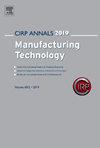Effect of layer thickness in laser powder bed fusion of HWTS 50 hot work tool steel
IF 3.6
3区 工程技术
Q2 ENGINEERING, INDUSTRIAL
引用次数: 0
Abstract
This work optimises and analyses the processing of a new lean tool steel (Osprey® HWTS 50), using laser powder bed fusion (PBF-LB) at 80 °C preheating and different layer thicknesses (20 µm vs. 40 µm). Full density is reached via a higher volumetric energy density (VED) for the lower layer thickness. After optimising contours, reducing surface roughness and ensuring no microcrack formation, the tensile properties are rather comparable in both cases (UTS ∼ 1500 MPa, elongation ∼ 10–12%). However, yield strength, hardness and residual stresses are slightly higher for the lower layer thickness. The geometrical freedom for intricate features is nevertheless comparable.
激光粉末床熔敷层厚度对HWTS 50热加工工具钢熔敷效果的影响
本工作优化和分析了一种新型精益工具钢(Osprey®HWTS 50),在80°C预热和不同层厚度(20 μ m和40 μ m)下使用激光粉末床熔合(PBF-LB)进行加工。对于较低的层厚度,通过较高的体积能量密度(VED)达到全密度。在优化轮廓,降低表面粗糙度并确保没有微裂纹形成后,两种情况下的拉伸性能相当相似(UTS ~ 1500 MPa,伸长率~ 10-12%)。然而,层厚越低,屈服强度、硬度和残余应力越高。然而,复杂特征的几何自由度是可以比较的。
本文章由计算机程序翻译,如有差异,请以英文原文为准。
求助全文
约1分钟内获得全文
求助全文
来源期刊

Cirp Annals-Manufacturing Technology
工程技术-工程:工业
CiteScore
7.50
自引率
9.80%
发文量
137
审稿时长
13.5 months
期刊介绍:
CIRP, The International Academy for Production Engineering, was founded in 1951 to promote, by scientific research, the development of all aspects of manufacturing technology covering the optimization, control and management of processes, machines and systems.
This biannual ISI cited journal contains approximately 140 refereed technical and keynote papers. Subject areas covered include:
Assembly, Cutting, Design, Electro-Physical and Chemical Processes, Forming, Abrasive processes, Surfaces, Machines, Production Systems and Organizations, Precision Engineering and Metrology, Life-Cycle Engineering, Microsystems Technology (MST), Nanotechnology.
 求助内容:
求助内容: 应助结果提醒方式:
应助结果提醒方式:


